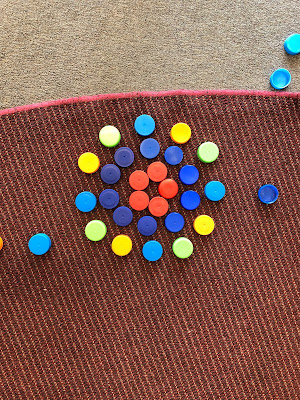So I took it way back and asked how we might make a pattern to represent adding 5.
And here is what happened:
I was underwhelmed. Surely we could come up with more than simple lines getting bigger by 5 each time. And was it a coincidence that just about every student had represented adding 5 in exactly the same way?
So, I drew a long breath and asked our favourite question:
"Can you do it a different way?"
And thankfully the answer was a resounding, "Yes!"
Here is what our next attempts looked like:
Several representations looked at groups of 5 being stacked up on top of each other. An interesting idea - take it into another dimension - but similar to the idea of parallel lines.
Two different students looked at representing the idea of adding 5 as an array.
Then we had 2 who make a circular pattern.
And also a radial pattern.
Then we had a few interesting ideas. Here, the student has decided to start at 3 (the central group of light blue lids) and then adding groups of 5 at each end. Her pattern went 3, 8, 13, 18...
This was a rather unusual idea. I can see the 5 blue lids. I can see several rows that have 5 yellow lids. But I could also see lots with 6 as well. What was going on?
"Well, you can start at any lid, and then count 5 in any direction. And then keep going."
Well, that certainly took it to places I wasn't expecting.
And then we had this one:
So, this student decided to reinvent numbers, place value, the counting system - everything.
Each group of lids represents a number in the counting by 5s pattern (5, 10, 15, 20, 25 etc) but the number of lids is not relevant. Each group has a unique arrangement, demonstrating an understanding that all numbers are unique and represent unique values.
So much more interesting than a series of parallel lines.
Like it. Well done, Year 2.













































